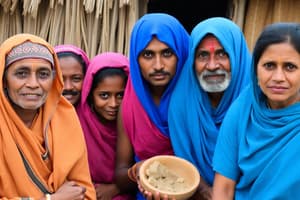Podcast
Questions and Answers
Adivasi/tribal/indigenous people make up less than 10% of the total population of India.
Adivasi/tribal/indigenous people make up less than 10% of the total population of India.
True (A)
The survival of adivasi communities in India is not based on the forests, lands, and natural resources.
The survival of adivasi communities in India is not based on the forests, lands, and natural resources.
False (B)
The adivasi communities in India have no connection to the forests, lands, and natural resources.
The adivasi communities in India have no connection to the forests, lands, and natural resources.
False (B)
The lives of adivasi communities in India are not closely intertwined with nature.
The lives of adivasi communities in India are not closely intertwined with nature.
The adivasi communities in India reside only in urban areas.
The adivasi communities in India reside only in urban areas.
Adivasi/tribal/indigenous people in India constitute exactly 8 percent of the total population.
Adivasi/tribal/indigenous people in India constitute exactly 8 percent of the total population.
The lives of adivasi communities in India are not dependent on the forests, lands, and natural resources.
The lives of adivasi communities in India are not dependent on the forests, lands, and natural resources.
The forests in India do not play a significant role in the survival of adivasi communities.
The forests in India do not play a significant role in the survival of adivasi communities.
Adivasi/tribal/indigenous people in India solely inhabit urban areas.
Adivasi/tribal/indigenous people in India solely inhabit urban areas.
The connection between adivasi communities and nature is superficial and not crucial for their survival.
The connection between adivasi communities and nature is superficial and not crucial for their survival.
Flashcards are hidden until you start studying




